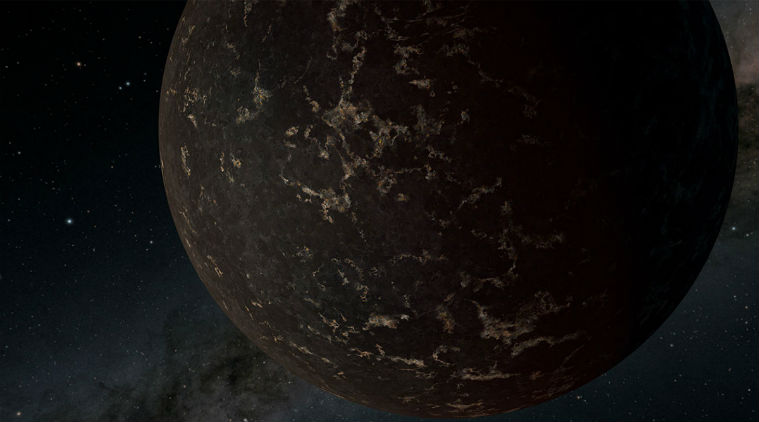- India
- International
NASA examines rocky exoplanet surface resembling that of Moon or Mercury
Space scientists have achieved to get a rare glimpse of a rocky exoplanet LHS 3844b located 48.6 lightyears away from the Earth. According to a NASA study, its surface may resemble that of the Moon or the Mercury.
 This artist’s illustration depicts the exoplanet LHS 3844b, which is 1.3 times the mass of Earth and orbits an M dwarf star. The planet’s surface may be covered mostly in dark lava rock, with no apparent atmosphere, according to observations by NASA’s Spitzer Space Telescope. (Image source: NASA)
This artist’s illustration depicts the exoplanet LHS 3844b, which is 1.3 times the mass of Earth and orbits an M dwarf star. The planet’s surface may be covered mostly in dark lava rock, with no apparent atmosphere, according to observations by NASA’s Spitzer Space Telescope. (Image source: NASA)
Scientists at NASA have achieved to get a rare glimpse of the conditions on the surface of a rocky exoplanet orbiting a star beyond the Sun. Using the data of NASA’s Spitzer Space Telescope, scientists have detected the light from the planet LHS 3844b, which is located 48.6 lightyears away from the Earth.
The LHS 3844b planet has a radius 1.3 times that of the Earth and it orbits a small, cool type of star called an M dwarf, which is the most common and long-lived type of star in the Milky Way. The observation marks the first time that Spitzer telescope’s data has been able to provide details about the atmosphere of a terrestrial world around an M dwarf star, NASA’s Jet Propulsion Laboratory (JPL) announced in a release.
Published in the Nature journal, the study is titled Absence of a Thick Atmosphere on the Terrestrial Exoplanet LHS 3844b. This study has found out that LHS 3844b planet is likely to lack atmosphere, and says that its surface may resemble that of the Earth’s Moon or the Mercury. It is also said that LHS 3844b could be covered in the same cooled volcanic material found in the dark areas of the surface of the Moon, called mare.
The LHS 3844b planet was discovered in 2018 by NASA’s Transiting Exoplanet Satellite Survey (TESS) mission through the transit method, which involves detecting when the observed light of a parent star dims due to a planet which is orbiting is between the star and Earth. Detecting light coming directly from a planet’s surface – another method – is difficult because the star is so much brighter and drowns out the planet’s light.
During its follow-up observations, the Spitzer telescope was able to detect light from the surface of LHS 3844b. The planet makes one full revolution around its parent star in only 11 hours. With such tight orbit, the LHS 3844b planet is most likely to be “tidally locked,” which means that when one side of a planet is permanently facing the star, the JPL statement said.

The side which is facing towards the star, or dayside, has a temperature of about 1,410 degrees Fahrenheit (770 degrees Celsius). Because it is extremely hot, the LHS 3844b planet radiates a lot of infrared light, which could be observed by the Spitzer telescope because it is an infrared telescope. Though the parent star is cool, it is still comparatively much hotter than the planet, so making direct observation of LHS 3844b’s dayside possible.
Also Read|Two elusive giant exoplanets discovered
By measuring the temperature difference between the hot and cold sides of the LHS 3844b, the team was able to find that there is a negligible amount of heat being transferred between the two. If the planet had an atmosphere, the hot air on the dayside would naturally expand, generating winds that would transfer heat around the planet. With a rocky surface and little to no atmosphere, there is no air present to transfer the heat.
“The temperature contrast on this planet is about as big as it can possibly be,” the JPL statement said quoting Laura Kreidberg, a researcher at the Harvard and Smithsonian Center for Astrophysics in Cambridge, Massachusetts, and lead author of the new study. Understanding factors which can preserve or destroy planetary atmospheres is part of how space scientists plan to search for habitable environments beyond our solar system.
The presence of an atmosphere on the Earth is the reason liquid water can exist on the surface, enabling life on the planet. On the other hand, the atmospheric pressure of Mars is now less than 1 per cent of that of the Earth, and the oceans and rivers that once dotted the Red Planet’s surface have disappeared.
“We’ve got lots of theories about how planetary atmospheres fare around M dwarfs, but we haven’t been able to study them empirically,” Kreidberg said. “Now, with LHS 3844b, we have a terrestrial planet outside our solar system where for the first time we can determine observationally that an atmosphere is not present.”
In comparison to Sun-like stars, M dwarfs stars emit high levels of ultraviolet (UV) light, which is harmful to life and can erode a planet’s atmosphere. They’re particularly violent in their youth, belching up a large number of flares, or bursts of radiation and particles that could strip away budding planetary atmospheres.
Also Read|Three exoplanets discovered around neighbouring star
The authors of the new study went one step further, using LHS 3844b’s surface albedo (or its reflectiveness) to try to infer its composition. The study shows that LHS 3844b is “quite dark,” according to co-author Renyu Hu, an exoplanet scientist at NASA’s Jet Propulsion Laboratory, which manages the Spitzer Space Telescope. He and his co-authors believe the planet is covered with basalt, a kind of volcanic rock. “We know that the mare of the Moon are formed by ancient volcanism,” Hu said, “and we postulate that this might be what has happened on this planet.”
More Tech
Apr 24: Latest News
- 01
- 02
- 03
- 04
- 05






























